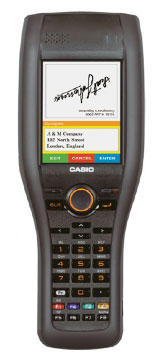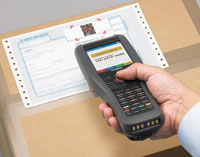|
Casio DT-X30
Ultra-rugged state-of-the-art handheld terminal/scanner/communicator
(by Kirk Linsky)
The Casio DT-X30, introduced in July of 2009, is offered by Casio's Industrial Handheld Division which works through a network of value added resellers and distributors.  Casio has been manufacturing and marketing industrial ruggedized mobile terminals for more than twenty years across the globe. Casio has been manufacturing and marketing industrial ruggedized mobile terminals for more than twenty years across the globe.
The DT-X30 is a very rugged state-of-the-art handheld computer whose wide range of wireless communication options (GSM/GPRS/EDGE for voice/data, Bluetooth, and GPS) allow, among many other applications, wireless loading and delivery completion reports from drivers as well as current driver current location for efficient routing. Intended use is in all industrial sectors including post office, private couriers, logistics, retail, parking enforcement, traffic infringement citations, meter readings, inspections, etc. The unit also includes a 2-megapixel digital camera with LED illuminator.
The DT-X30 is a "grip-type" handheld terminal whose external shape was developed using the ISO13407 Human-Centered Design process resulting in a rounded and dimpled form that fits naturally in anyone's palm allowing the fingers to rest firmly in the groove on the back of the case. The device includes an integrated 1D/2D imager that can read and decode a widfe variety of 1D and 2D symbologies. Measuring 3.4 x 9.5 x 1.8 inches and weighing 1.3 pounds, battery included, the DT-X30 is a tough, substantial unit designed to survive even in extreme environmental conditions.
 As is almost always the case with Casio products, the DT-X30 is technologically advanced and feature-rich. It is based on the 624MHz version of Marvell's powerful yet economic PXA320 processor and runs Windows Mobile 6.1. Memory consists of 128MB of RAM and ROM each. A microSD slot serves for memory expansion and also offers SDIO capability. The transflective QVGA touch display measures a full 3.5 inches diagonally (full VGA would have been nice). A 29-key keypad and three trigger keys allow rapid data entry.
As is almost always the case with Casio products, the DT-X30 is technologically advanced and feature-rich. It is based on the 624MHz version of Marvell's powerful yet economic PXA320 processor and runs Windows Mobile 6.1. Memory consists of 128MB of RAM and ROM each. A microSD slot serves for memory expansion and also offers SDIO capability. The transflective QVGA touch display measures a full 3.5 inches diagonally (full VGA would have been nice). A 29-key keypad and three trigger keys allow rapid data entry.
For communication there is Bluetooth 2.0, a SIM slot of GSM/GPRS/EDGE voice/data communication and, rare these days, IrDA.
As far as ruggedness goes, the Casio DT-X30 is built to survive substantial abuse. It is sealed to IP67 level, where the "6" stands for total protection against dust and the "7" for a waterproof design that can even handle immersion into water. The unit can handle drops from as high as six feet, and operate within a very wide temperature range of -4 to 122 degrees Fahrenheit.
Available for use with the DT-X30 are a USB cradle, an Ethernet crade, and single or multiple unit cradle-style battery chargers. While not officially positioned as such, the DT-X30 seems the logical replacement for the older DT-X10/X11.
|
|
|
|
Specifications Casio DT-X30
|
|
Added/changed
|
Added 11/2009
|
|
Form-factor
|
Hanhdheld terminal
|
CPU Speed
|
Marvell PXA320/624 MHz
|
OS
|
Windows Mobile 6.1
|
RAM/ROM
|
128MB/128MB
|
Card slots
|
1 microSD, 1 SIM
|
Display type
|
Transflective color TFT LCD
|
Display size/res
|
3.5"/240 x 320
|
Digitizer/pens
|
Touch panel/1
|
Keyboard/keys
|
29-key (alpha/numeric keys, CLR, Execute, Cursor keys, Power, Fn, F1 to F8 keys), Center Trigger key, R/L Trigger keys
|
Navigation
|
4 navigation keys + stylus
|
Housing
|
Plastic/rubber
|
Operating Temp
|
-4 to 122F
|
Sealing
|
IP67
|
Shock
|
6-foot drop
|
Safety
|
EN60950-1
|
EMI
|
EN55022, EN61000-3-2, EN61000-3-3, CFR 47 Part 15 Subpart B
|
Size (WxHxD)
|
3.4 x 9.5 x 1.8 inches
|
Weight
|
21 oz. with standard battery
|
Power
|
7.4V/2,000 mAH Li-Ion and rechargeable Lithium memory backup battery
|
Interface
|
USB 1.1 (host and client), built-in speaker, 2MP digital camera with LED flash, built-in micorphone, 1D/2D CMOS imager
|
Wireless
|
Bluetooth 2.0 + EDR, quadband GSM/GPRS/EDGE, 16-channel GPS
|
Price
|
inquire
|
Contact
|
www.casio.com
|
Brochure
|
DT-X30 brochure
|
|
|
Windows Mobile Info
|
Windows Mobile 6
Windows Mobile 5
Windows Mobile Smartphone
Windows Mobile 2003
Windows CE .Net
Windows for Pocket PC 2002
Pocket PC intro 2000
Windows CE H/PC Pro 1998
Windows CE 2.0 1997
|
|
Search
|
|
|
|



